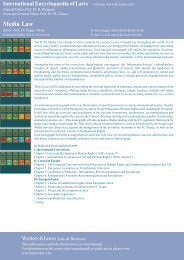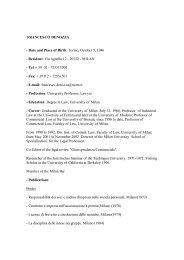USA - International Encyclopaedia of Laws
USA - International Encyclopaedia of Laws
USA - International Encyclopaedia of Laws
You also want an ePaper? Increase the reach of your titles
YUMPU automatically turns print PDFs into web optimized ePapers that Google loves.
7–10 General Introductionhas slackened, as only eighteen states have adopted new constitutions. However,the pace <strong>of</strong> constitutional amendment has increased. Current state constitutionsaverage over 120 amendments, with most amendments adopted since 1940.7. Three key issues have dominated the history <strong>of</strong> state constitutionaldevelopment. 1 The first <strong>of</strong> these issues is the distribution <strong>of</strong> political poweramong groups and regions within the individual states. As various groups gainedpolitical strength, they pressed for constitutional recognition <strong>of</strong> their numbersand their interests. In some instances, they sought a change in the system <strong>of</strong>representation in the state legislature; in others, the enfranchisement <strong>of</strong> previouslyexcluded groups. Conflicts over the apportionment <strong>of</strong> state legislatures andover qualifications for voting have been common in the states.1. For more detailed discussion <strong>of</strong> state constitutional history, see G. Alan Tarr, UnderstandingState Constitutions (Princeton, N.J.: Princeton University Press, 1998), chapters 3–5.8. Turning first to disputes about apportionment, during the early nineteenthcentury, these conflicts typically pitted the coastal regions <strong>of</strong> the original statesagainst regions in the interior <strong>of</strong> those states. The interior regions had experiencedsubstantial population growth, and they wanted that growth reflected instate government. The coastal regions only reluctantly ceded political power,and thus conflicts in states such as Virginia and North Carolina continued forover half a century. Later in the nineteenth century and through much <strong>of</strong> thetwentieth century, the conflict typically involved rural regions, which were overrepresentedin state legislatures, and urban areas. Ultimately, their continuingdispute over apportionment was resolved by the United States Supreme Court,which in 1964 mandated equi-populous districts for both houses <strong>of</strong> statelegislatures.9. Conflict over qualifications for voting were likewise intense. During thelate eighteenth century, most states required that voters be male adult propertyholders.From 1820–1860, restrictions on white male suffrage came under fierceattack and were largely eliminated, although states imposed new restrictions onblack suffrage. The adoption <strong>of</strong> the Fifteenth Amendment to the United StatesConstitution in 1870 guaranteed voting rights for blacks, but Southern states inthe late nineteenth century and the first half <strong>of</strong> the twentieth century ignoredthis requirement, adopting literacy tests, poll taxes, and other state constitutionalbarriers to black suffrage. Many <strong>of</strong> these barriers, which were unequally appliedin order to disenfranchise blacks, were not eliminated until Congress enactedthe Voting Rights Act <strong>of</strong> 1965.During the late nineteenth and early twentieth centuries, Wyoming and severalother states pioneered in granting the franchise to women. Eventually the federalgovernment followed their lead, enshrining women’s suffrage in the NineteenthAmendment to the U.S. Constitution.10. A second recurring constitutional issue has involved the scope <strong>of</strong> stategovernment. The initial state constitutions imposed few restrictions on statelegislatures, trusting in popular election to prevent abuses <strong>of</strong> power. However,12 – <strong>USA</strong> (Sub-national) Constitutional Law – Suppl. 34 (October 1999)
















